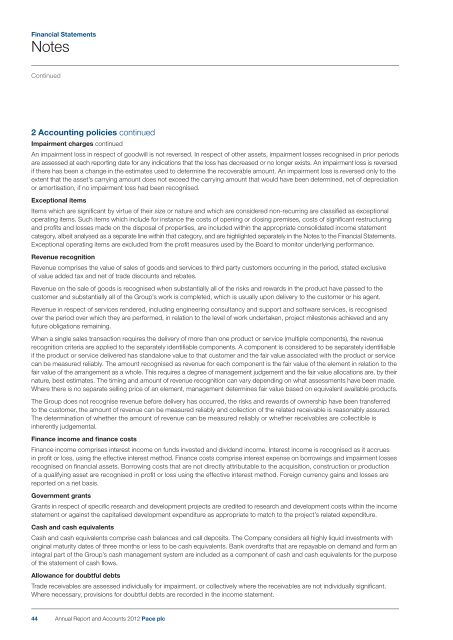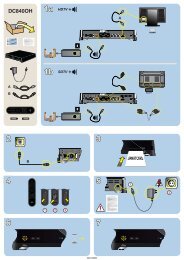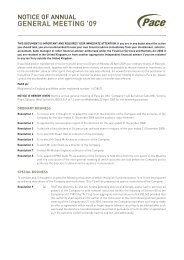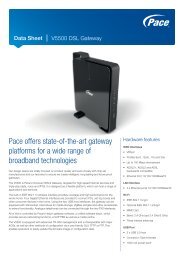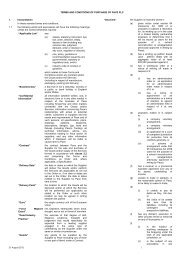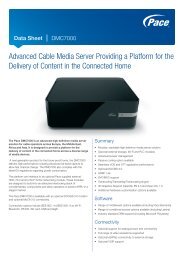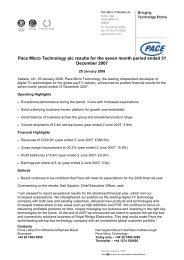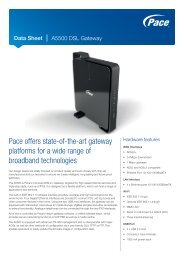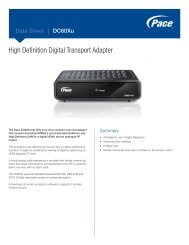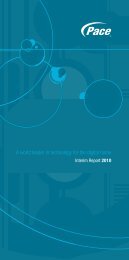Pace plc Annual Report and Accounts 2012 - Financial Statements
Pace plc Annual Report and Accounts 2012 - Financial Statements
Pace plc Annual Report and Accounts 2012 - Financial Statements
You also want an ePaper? Increase the reach of your titles
YUMPU automatically turns print PDFs into web optimized ePapers that Google loves.
<strong>Financial</strong> <strong>Statements</strong>NotesContinued2 Accounting policies continuedImpairment charges continuedAn impairment loss in respect of goodwill is not reversed. In respect of other assets, impairment losses recognised in prior periodsare assessed at each reporting date for any indications that the loss has decreased or no longer exists. An impairment loss is reversedif there has been a change in the estimates used to determine the recoverable amount. An impairment loss is reversed only to theextent that the asset’s carrying amount does not exceed the carrying amount that would have been determined, net of depreciationor amortisation, if no impairment loss had been recognised.Exceptional itemsItems which are significant by virtue of their size or nature <strong>and</strong> which are considered non-recurring are classified as exceptionaloperating items. Such items which include for instance the costs of opening or closing premises, costs of significant restructuring<strong>and</strong> profits <strong>and</strong> losses made on the disposal of properties, are included within the appropriate consolidated income statementcategory, albeit analysed as a separate line within that category, <strong>and</strong> are highlighted separately in the Notes to the <strong>Financial</strong> <strong>Statements</strong>.Exceptional operating items are excluded from the profit measures used by the Board to monitor underlying performance.Revenue recognitionRevenue comprises the value of sales of goods <strong>and</strong> services to third party customers occurring in the period, stated exclusiveof value added tax <strong>and</strong> net of trade discounts <strong>and</strong> rebates.Revenue on the sale of goods is recognised when substantially all of the risks <strong>and</strong> rewards in the product have passed to thecustomer <strong>and</strong> substantially all of the Group’s work is completed, which is usually upon delivery to the customer or his agent.Revenue in respect of services rendered, including engineering consultancy <strong>and</strong> support <strong>and</strong> software services, is recognisedover the period over which they are performed, in relation to the level of work undertaken, project milestones achieved <strong>and</strong> anyfuture obligations remaining.When a single sales transaction requires the delivery of more than one product or service (multiple components), the revenuerecognition criteria are applied to the separately identifiable components. A component is considered to be separately identifiableif the product or service delivered has st<strong>and</strong>alone value to that customer <strong>and</strong> the fair value associated with the product or servicecan be measured reliably. The amount recognised as revenue for each component is the fair value of the element in relation to thefair value of the arrangement as a whole. This requires a degree of management judgement <strong>and</strong> the fair value allocations are, by theirnature, best estimates. The timing <strong>and</strong> amount of revenue recognition can vary depending on what assessments have been made.Where there is no separate selling price of an element, management determines fair value based on equivalent available products.The Group does not recognise revenue before delivery has occurred, the risks <strong>and</strong> rewards of ownership have been transferredto the customer, the amount of revenue can be measured reliably <strong>and</strong> collection of the related receivable is reasonably assured.The determination of whether the amount of revenue can be measured reliably or whether receivables are collectible isinherently judgemental.Finance income <strong>and</strong> finance costsFinance income comprises interest income on funds invested <strong>and</strong> dividend income. Interest income is recognised as it accruesin profit or loss, using the effective interest method. Finance costs comprise interest expense on borrowings <strong>and</strong> impairment lossesrecognised on financial assets. Borrowing costs that are not directly attributable to the acquisition, construction or productionof a qualifying asset are recognised in profit or loss using the effective interest method. Foreign currency gains <strong>and</strong> losses arereported on a net basis.Government grantsGrants in respect of specific research <strong>and</strong> development projects are credited to research <strong>and</strong> development costs within the incomestatement or against the capitalised development expenditure as appropriate to match to the project’s related expenditure.Cash <strong>and</strong> cash equivalentsCash <strong>and</strong> cash equivalents comprise cash balances <strong>and</strong> call deposits. The Company considers all highly liquid investments withoriginal maturity dates of three months or less to be cash equivalents. Bank overdrafts that are repayable on dem<strong>and</strong> <strong>and</strong> form anintegral part of the Group’s cash management system are included as a component of cash <strong>and</strong> cash equivalents for the purposeof the statement of cash flows.Allowance for doubtful debtsTrade receivables are assessed individually for impairment, or collectively where the receivables are not individually significant.Where necessary, provisions for doubtful debts are recorded in the income statement.44<strong>Annual</strong> <strong>Report</strong> <strong>and</strong> <strong>Accounts</strong> <strong>2012</strong> <strong>Pace</strong> <strong>plc</strong>


